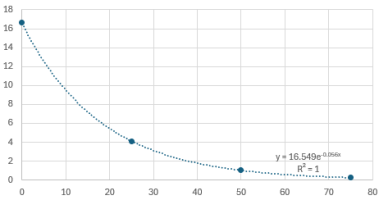endoplasmicreticulum
New member
- Joined
- Feb 4, 2021
- Messages
- 9
Can someone please explain how this is the answer? I am simply confused on how they arrived to that answer for the exponential model. Because, the answer I got was f(x) = 16.634(0.250)^x

I thought that to find the exponential model, you were supposed to recognize the pattern of y, (which is multiplying by 0.250, no?) and then, to find the "a" in y = ab^x, you would just insert the y value where the input = 0 (in this case, 16.634 ?)
Any help would be greatly appreciated, thanks.

I thought that to find the exponential model, you were supposed to recognize the pattern of y, (which is multiplying by 0.250, no?) and then, to find the "a" in y = ab^x, you would just insert the y value where the input = 0 (in this case, 16.634 ?)
Any help would be greatly appreciated, thanks.

